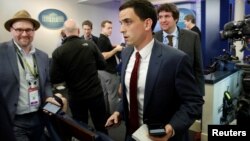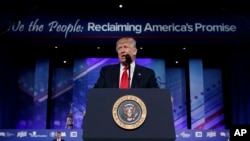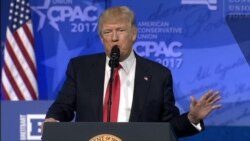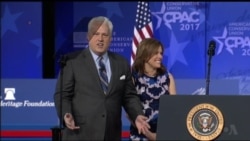The White House came under sharp criticism Friday after blocking a number of news organizations from a daily question-and-answer session with Press Secretary Sean Spicer.
Several news groups that have been critical of President Donald Trump, including CNN and The New York Times, were among those excluded from the briefing.
Some outlets seen as more sympathetic to Trump, including Breitbart News, the One America News Network and the Washington Times, were allowed in or invited to join the briefing.
Other mainstream outlets were allowed to participate, including the ABC, CBS, NBC and Fox broadcast networks. Some news organizations, including The Associated Press, refused to participate in solidarity with those excluded.
A VOA correspondent at the White House Friday was not invited to join the briefing and did not attend the meeting with Spicer.
Meeting in Spicer’s office
The off-camera briefing — the type of meeting White House reporters call a “gaggle” — was held in Spicer’s office in place of the daily on-camera press briefing, a more formal session that all credentialed news outlets are entitled to attend.
The White House Correspondents’ Association, an organization of journalists who cover the president, sharply rebuked the White House for Friday’s move and said it would be discussed further.
“The WHCA board is protesting strongly against how today’s gaggle is being handled by the White House,” said Jeff Mason, the WHCA president, who works for Reuters.
Deputy press secretary Sarah Huckabee Sanders said the briefing Friday was organized according to standard White House practice.
“We were trying to do an informal gaggle,” she told VOA by telephone. “We had the pool (reporters) come in so that everyone would be represented and get the information. And we had a little extra room (in Spicer’s office), so a few others were invited.”
Objections from Times, AP
There was quick criticism from news organizations.
New York Times executive editor Dean Baquet said: “Nothing like this has ever happened at the White House in our long history of covering multiple administrations of different parties.”
A statement from The Associated Press said: “The AP believes the public should have as much access to the president as possible.”
The Trump administration has been criticized in the past for attempting to sideline certain media outlets it sees as unfriendly. In a tweet last week, Trump included The New York Times, NBC, ABC, CBS and CNN in a list of news media that he described as purveyors of “fake news” and “enemies of the American people.”
A number of both current and former White House reporters also weighed in on Twitter.
The unusual ban came just hours after Trump repeated his recent attacks on the news media during a speech Friday morning before a cheering audience of thousands at the Conservative Political Action Conference. Trump said no journalists should use anonymous sources in their reporting.
Trump derides ‘sources’
The president claimed reporters have invented anonymous sources to amplify their critical stories about him, in order to make him look bad. He did not mention a similar custom long practiced by information officers throughout the U.S. government, who disclose information to reporters on an anonymous basis, or “on deep background,” or attributed to an unnamed “senior U.S. official.”
“I’m against the people that make up stories and make up sources,” Trump said of the press corps that covers him. “They shouldn’t be allowed to [quote] sources unless they use [the sources’] names,” Trump said. If his conditions were met, he said, “There would be no more sources.”
Watch: Trump: 'We are Fighting the Fake News'
American reporters frequently quote anonymous sources in news stories that deal with confidential or highly compartmentalized information. Such arrangements are usually insisted upon by the sources, so they can avoid repercussions.
Trump specifically referred to a Washington Post story this month that reported nine current or former intelligence officials had said Trump’s former national security adviser, Michael Flynn, misrepresented or minimized his conversations with a senior Russian diplomat regarding U.S. sanctions levied against Moscow.
‘They make up sources’
Trump claimed all nine sources were invented by the reporter who wrote the story. “They make up sources,” he said. “They are very dishonest people.”
The president claimed reporters hide behind the protections of the U.S. Constitution — specifically, the First Amendment, which guarantees Americans free speech rights and a free press — to publish lies about him.
“Many of these groups are part of the large media corporations and they have their own agenda — and it’s not your agenda,” Trump told those at the conference. “It doesn’t represent the people, it will never represent the people, and we’re going to do something about it.”
Washington Post executive editor Marty Baron responded to Trump’s comments almost immediately in a statement, standing behind the report and saying it has since been proved true by on-the-record reporting.
“The story led directly to [Flynn’s] dismissal as national security adviser. Calling press reports fake doesn’t make them so,” Barron wrote.
Watch: Trump Receives Rapturous Welcome at CPAC
Trump supporters
Trump supporters who cheered his remarks said afterward they agreed with the president’s contention that reporters make up fake sources to hurt him.
Hunter Dworksy, a former state director for Trump’s campaign in Delaware, told VOA the president’s words and actions are routinely misrepresented by corporate media outlets such as CNN and NBC. Trump criticizes those outlets because they undermine his biggest asset, his ability to connect with people, Dworksy said: “He is a guy that is talking to you. He hits you right in the heart and that’s how he gets his message across.”
Ariel Kohane, a Republican Party worker from New York City and member of the group Jews for Trump, said he is glad to have a leader who is willing to criticize reporters when he feels they have misrepresented the truth.
“We have to get the facts, and we have to call the media out on it,” Kohane said.
Trump did specify that the “enemy of the people” label he aimed at reporters a week earlier did not apply to the entire press corps, but only to the “fake news media,” which he defined as a smaller group of reporters who actively misconstrue his words.
“In fact, in covering my comments, the dishonest media did not explain that I called the ‘fake news’ the enemy of the people — the ‘fake news,’” Trump said. “They dropped off the word ‘fake.’ And all of a sudden the story became the media is the enemy.”
Watch: Trump: 'I'm Here Fighting For You'
In another portion of his speech to the conservative audience, Trump laid out his vision for that political group, and his idea that “we are a nation that put, and will put, its own citizens first.” The crowd answered him with repeated chants, of “USA! USA! USA!”
He also spoke briefly about his immigration policies, which Trump said are aimed at deporting “bad people” such as drug dealers and murderers from the U.S.
Trump’s speech was the highlight of this year’s CPAC and gave the event a newly energized spirit, with Republicans in control of the White House and Congress for the first time in 10 years.
Past appearances
His speech Friday was Trump’s fifth appearance at the annual conservative conference, and he was received by the crowd much more enthusiastically than in past years.
In his first appearance at CPAC in 2011, Trump, then a well-known reality television star, floated the idea of launching a presidential campaign. However, the crowd turned against him when he disparaged former Texas Congressman Ron Paul’s presidential hopes that year.
“I like Ron Paul, he’s a good guy, but honestly he has zero chance of getting elected you have to win an election,” Trump said. “And I tell you, if I run and if I win, this country will be respected again.”
Trump did not run for president in 2012, and he skipped CPAC that year as well. He returned to the conservative group in 2013 to criticize failed 2012 Republican presidential candidate Mitt Romney for not running a more aggressive campaign.
In 2014 and 2015, Trump’s speeches previewed several familiar themes seen throughout his presidential campaign: attacks on Democratic candidate Hillary Clinton and pledges to “make America great again.”















